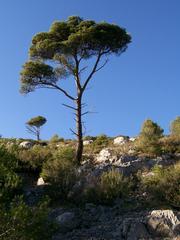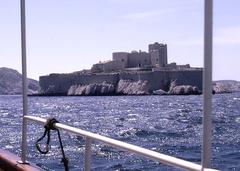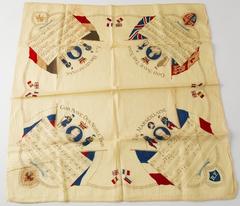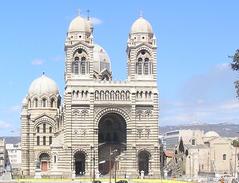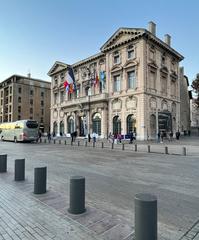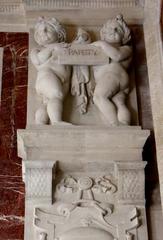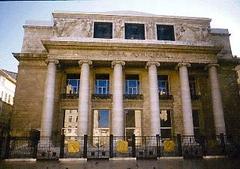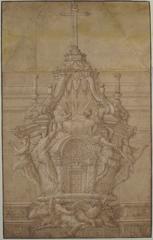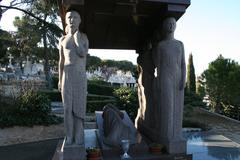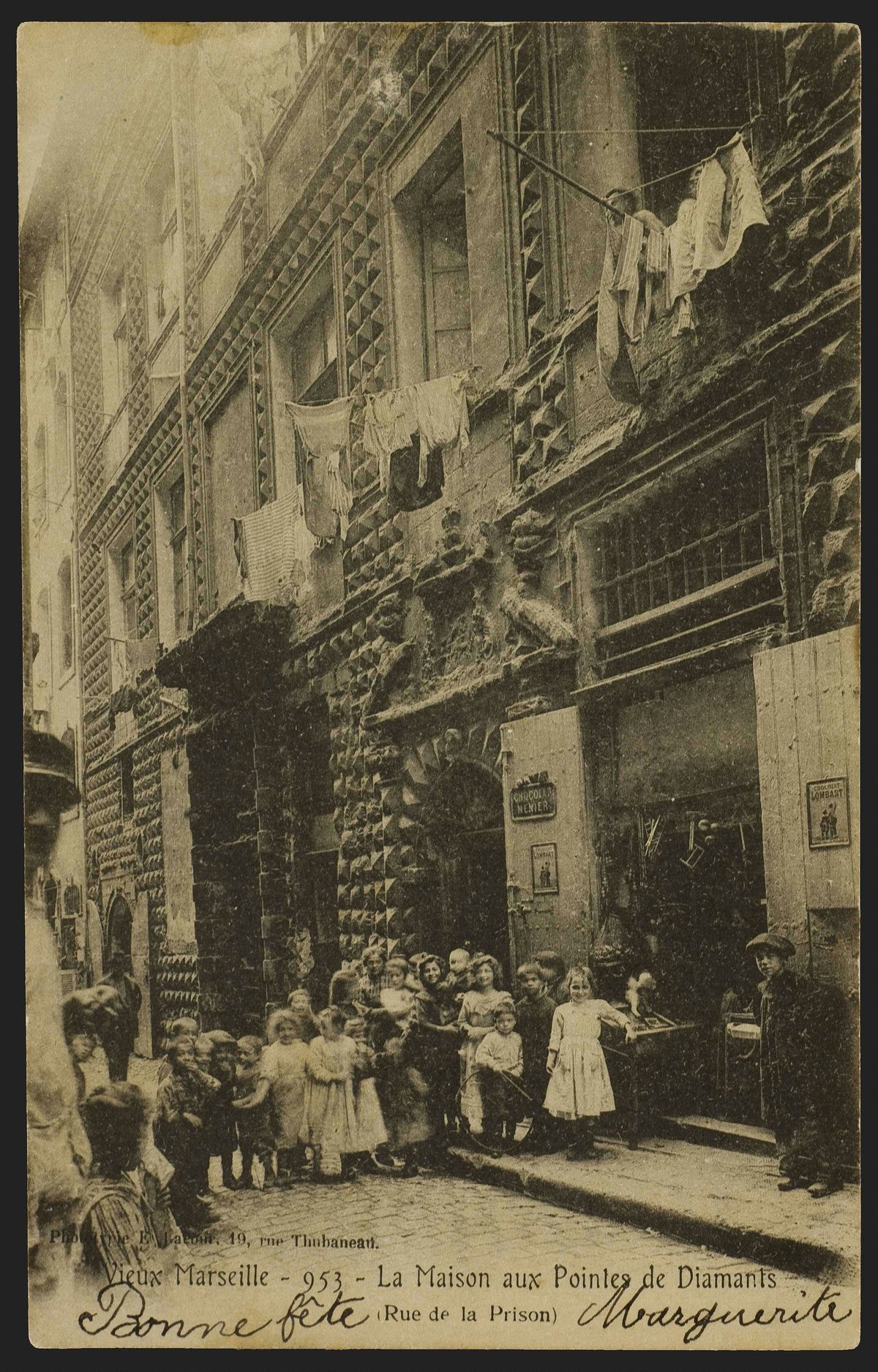
Comprehensive Guide to Visiting Maison Diamantée, Marseille, France
Date: 01/08/2024
Introduction
La Maison Diamantée, often referred to as the Diamond House, is a quintessential historical landmark nestled in the heart of the Panier district in Marseille, France. This architectural gem, dating back to between the late 16th and early 18th centuries, stands as a testament to the city’s vibrant history and cultural evolution. Its distinctive façade, adorned with diamond-shaped stones, not only gives the building its name but also reflects the Renaissance architectural influences from Italy, particularly the Medici buildings. The Maison Diamantée was commissioned by affluent Italian and Spanish merchants, and its unique style, known as ‘bossage prismatique,’ was intended to showcase their wealth and sophistication (Marseille Tourisme). Over the centuries, this building has housed notable families, including the Saboulin Bollena and Castellane Majastre families, and has played a pivotal role in Marseille’s mercantile community (Marseille.fr). Despite facing periods of decline, La Maison Diamantée has been meticulously restored and preserved, ensuring its place as a symbol of Marseille’s rich heritage and enduring legacy (Nomads Travel Guide).
Table of Contents
- Introduction
- Historical Background
- Visitor Information
- Cultural Impact
- Preservation Efforts
- FAQ
- Conclusion
Historical Background
Origins and Construction
La Maison Diamantée, also known as the Diamond House, is one of the oldest and most historically significant buildings in Marseille. Its construction date is uncertain, but it is estimated to have been built between the late 16th and early 18th centuries. The building stands on the site of the former garden of the ‘Palais de Provence,’ and its development was commissioned by wealthy Italian and Spanish merchants. The architectural style of La Maison Diamantée draws inspiration from the Medici buildings in Italy, featuring a façade adorned with pointed stone known in architectural jargon as ‘diamond point boss’ (Marseille Tourisme).
Architectural Significance
The Maison Diamantée’s façade is its most striking feature, covered with stones cut into diamond shapes, which gives the building its name. This architectural style, known as ‘bossage prismatique,’ was quite innovative for its time and reflects the influence of Renaissance architecture from Italy (Wikipedia). The building’s design was intended to showcase the wealth and sophistication of its owners, who were prominent figures in Marseille’s mercantile community.
Prominent Residents
Over the centuries, La Maison Diamantée has been home to several notable families from Marseille. Among its early residents were the Saboulin Bollena and Castellane Majastre families. Pierre de Saboulin-Bolléna, who served as the Premier Echevin (First Alderman) of Marseille, and his nephew François de Saboulin Bollena, who also held significant municipal positions, were among the distinguished occupants (Marseille.fr). These families played crucial roles in the city’s governance and trade, further cementing the building’s status as a symbol of Marseille’s historical and economic significance.
Decline and Restoration
By the end of the 19th century, La Maison Diamantée had fallen into disrepair. The building was occupied by port employees and Italian immigrants, reflecting the changing demographics and economic conditions of the area (Nomads Travel Guide). On the eve of the First World War in 1914, the building was in a dilapidated state and was saved from ruin by the cultural association ‘Art et charité,’ which later bequeathed it to the Comité du Vieux-Marseille (Marseille Tourisme).
Historical Monument Status
On November 10, 1925, La Maison Diamantée was classified as a French historical monument, recognizing its architectural and historical importance (Wikipedia). This designation helped ensure the building’s preservation and highlighted its significance as one of the few remaining symbols of Marseille’s past.
World War II and Beyond
During the Second World War, La Maison Diamantée narrowly escaped destruction. In 1943, the German authorities ordered the demolition of many old districts in Marseille, but the building was spared (Marseille Tourisme). From 1967 to 2009, it housed the collections of the Musée du Vieux Marseille, which have since been relocated to the Marseille History Museum. In 2013, the building played a role in the Marseille Provence 2013, European Capital of Culture, hosting the event’s organizing association (Nomads Travel Guide).
Visitor Information
Current Use
Today, La Maison Diamantée houses municipal services and is not open for public tours. However, visitors can still admire its magnificent staircase and the exterior’s unique architectural features while strolling through the Panier district, located at 2 rue de la Prison in the 2nd district (Nomads Travel Guide). The building remains a testament to Marseille’s rich history and its enduring legacy as a hub of trade and cultural exchange.
Visiting Hours and Tickets
While La Maison Diamantée itself is not open for public tours, the Panier district offers a plethora of historical sites and attractions that visitors can explore. Check the official tourism website for up-to-date information on visiting hours and ticket prices for nearby attractions.
Travel Tips and Nearby Attractions
When visiting the Panier district, be sure to wear comfortable walking shoes as the area is best explored on foot. Nearby attractions include the Vieille Charité, the Cathédrale de la Major, and the MuCEM (Museum of European and Mediterranean Civilisations). For a panoramic view of Marseille, head to the Basilique Notre-Dame de la Garde, which is a short distance away.
Special Events and Guided Tours
La Maison Diamantée occasionally hosts special cultural events and exhibitions. Check the Marseille cultural events calendar for upcoming events. Guided tours of the Panier district, which include a walk past La Maison Diamantée, are available through various tour operators.
Photographic Spots
The unique façade of La Maison Diamantée makes it a favorite spot for photographers. Capture the intricate diamond-shaped stones in the golden light of the afternoon for the best shots. The narrow streets and colorful buildings of the Panier district also offer excellent photographic opportunities.
Cultural Impact
La Maison Diamantée is more than just an architectural marvel; it is a living piece of Marseille’s history. The building’s past reflects the city’s openness to Mediterranean influences and its role as a major trading center. The presence of prominent families and later, the working-class residents, illustrates the social and economic changes that have shaped Marseille over the centuries (Marseille.fr).
Preservation Efforts
The preservation of La Maison Diamantée has been a collaborative effort involving various cultural and historical organizations. The Comité du Vieux-Marseille, in particular, has played a significant role in maintaining the building and ensuring its historical integrity. These efforts have helped keep the building as a vital part of Marseille’s cultural heritage, allowing future generations to appreciate its historical significance (Marseille Tourisme).
FAQ
Q: What are the visiting hours for La Maison Diamantée?
A: La Maison Diamantée is not open for public tours. However, visitors can explore the exterior and nearby attractions in the Panier district. Check the official tourism website for more information.
Q: Do I need to buy tickets to visit La Maison Diamantée?
A: No tickets are required to view the exterior of La Maison Diamantée. For nearby attractions, visit the official tourism website for ticket prices and availability.
Q: Are there guided tours available?
A: Yes, guided tours of the Panier district, which include a walk past La Maison Diamantée, are available through various tour operators. Check with local tour operators for more information.
Q: What are some nearby attractions?
A: Nearby attractions include the Vieille Charité, the Cathédrale de la Major, and the MuCEM. For a panoramic view of Marseille, visit the Basilique Notre-Dame de la Garde.
Q: Is La Maison Diamantée accessible for people with disabilities?
A: Since La Maison Diamantée is not open for public tours, accessibility information is limited. However, the Panier district is a historic area with narrow streets and uneven surfaces, which may pose challenges for visitors with mobility issues.
Conclusion
La Maison Diamantée stands as a remarkable monument in Marseille, embodying the city’s rich history and architectural heritage. Its journey from a luxurious residence to a dilapidated building and finally to a preserved historical monument is a testament to the enduring legacy of Marseille’s past. Visitors to the Panier district can still marvel at its unique façade and imagine the vibrant history that unfolded within its walls. The building’s preservation is a testament to the collaborative efforts of various cultural and historical organizations, ensuring that future generations can continue to appreciate its historical significance. Whether you are a history enthusiast, an architecture aficionado, or a curious traveler, La Maison Diamantée is a must-see landmark that encapsulates the enduring spirit of Marseille (Marseille Tourisme).
References
- Marseille Tourisme. (n.d.). The Maison Diamantée. Retrieved from Marseille Tourisme
- Marseille.fr. (n.d.). La Maison Diamantée. Retrieved from Marseille.fr
- Nomads Travel Guide. (n.d.). Maison Diamantée. Retrieved from Nomads Travel Guide
- Wikipedia. (n.d.). Maison Diamantée. Retrieved from Wikipedia
- Marseille Secrete. (n.d.). Maison Diamantée Marseille. Retrieved from Marseille Secrete



